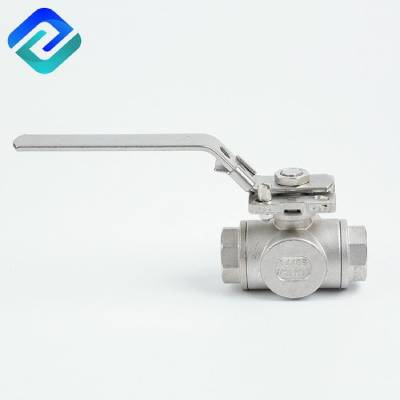Three-Way Ball Valve has T type and L type. The T-type can connect three orthogonal pipelines with each other and cut off the third channel, which can split and merge. The L three-way ball valve type can only connect two orthogonal pipelines, and cannot maintain the third pipeline to communicate with each other at the same time. It only plays a role of distribution.
The three-way four-seat ball valve with L-shaped flow channel adopts two-seat seat. Mainly used for reversing the flow path.
The three-way four-seat ball valve with T-shaped flow channel adopts a four-sided valve seat, which is balanced in force to ensure a reliable seal on the closed channel. Mainly used for split flow, mixed flow, commutation and full opening of three channels.
1. The fluid resistance is small, and its resistance coefficient is equal to that of a pipe section of the same length.
2. Simple structure, small size and light weight.
3. It is tight, reliable, and well sealed, and has been widely used in vacuum systems.
4. It is easy to operate and open and close quickly. It only needs to rotate 90° from fully open to fully closed, which is convenient for remote control.
5. The maintenance is convenient, the structure of the ball valve is simple, the sealing ring is generally movable, and it is convenient to disassemble and replace.

Three-Way Ball Valve
6. When fully open or fully closed, the sealing surface of the ball and the valve seat is isolated from the medium, and the medium will not cause erosion of the valve sealing surface when the medium passes.
7. It has a wide range of applications, with a diameter ranging from a few millimeters to a few meters, and can be applied from high vacuum to high pressure.
High platform ball valves can be divided into Straight-Through Type Ball Valve, three-way ball valves and right-angle ball valves according to their channel positions. The latter two ball valves are used to distribute the medium and change the flow direction of the medium.
1 In the closed position, the ball is pressed against the valve seat by the mechanical pressure of the valve stem.
2 When the handwheel is turned counterclockwise, the valve stem moves in the opposite direction, and the bottom angular plane makes the ball free from the valve seat.
3 The valve stem continues to rise, and interacts with the guide pin in the spiral groove of the valve stem, so that the ball begins to rotate without friction.
4 Until it reaches the fully open position, the valve stem is raised to the limit position and the ball rotates to the fully open position.
1 When it is closed, turn the handwheel clockwise, the valve stem begins to descend and the ball leaves the valve seat to start rotating.
2 Continue to rotate the hand wheel, and the valve stem is acted on by the guide pin embedded in the upper spiral groove, so that the valve stem and the ball rotate 90° at the same time.
3 When it is about to close, the ball has rotated 90° without contact with the valve seat.
4 In the last few turns of the handwheel, the angular plane at the bottom of the valve stem mechanically wedges and presses the sphere to make it tightly press on the valve seat to achieve a complete seal.
If you have more questions to consult, please contact the Three-Way Ball Valve Supplier
Copyright:@2020-2021
Comments Please sign in or sign up to post.
0
0 of 500 characters used